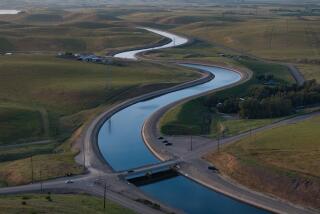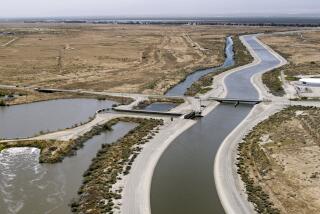California moves ahead with one delta tunnel, scaling back ambitious water delivery project
State officials Wednesday said they will press ahead with a smaller version of a long-planned water delivery project, initially building one, instead of two, massive tunnels in the heart of California’s vast waterworks.
The decision to downsize California WaterFix boils down to money. The urban and agricultural water districts that are supposed to pay for the multibillion dollar project have only committed to enough funding for one water tunnel that would extend 35 miles under the Sacramento-San Joaquin Delta.
The reduction is yet another setback for a decade-old proposal that was originally pitched as a grand fix for the ecologically failing delta and the key to sending more water south to San Joaquin Valley agribusiness and Southern California cities.
Questions about WaterFix’s impact on the delta environment, opposition by delta interests and funding shortfalls have steadily whittled down the project’s ambitions and scope. A major habitat restoration program was dropped. The construction footprint was reduced. And now, instead of a $17-billion, two-tunnel project, the state is planning to move ahead with one tunnel that would cost $10.7 billion.
The changes are likely to add more delays to WaterFix. The Metropolitan Water District of Southern California and other agencies that approved funding for the two-tunnel plan have to decide if a scaled-back version will deliver enough water to maintain the project’s appeal.
“Metropolitan recognizes that a staged approach to California WaterFix reflects the project’s economic realities at this time,” Metropolitan general manager Jeffrey Kightlinger said in a statement. “Metropolitan continues to explore pathways that align cost and benefits and will work with our partners on a financing agreement. But the final decision regarding participation in the staged project will ultimately be made by our board of directors.”
The Department of Water Resources said it would take until October to complete a supplemental environmental review of the modified plans.
And shrinking the project won’t quiet criticism that big tunnel diversions on the Sacramento River will hurt migrating salmon and worsen water quality in the delta.
“The science is clear: We need to increase [delta] outflow and reduce diversions,” said Doug Obegi, an attorney with the Natural Resources Defense Council, an environmental group.
The project also has yet to finish the permitting process, which could throw still more hurdles in its path.
The tunnel proposal is the latest attempt to halt the delta’s steep environmental decline while continuing major water exports that have helped drive that decline. The project’s many stumbles illustrate how difficult — if not impossible — it is to attain that goal.
In a memo to water contractors, state officials Wednesday said the ultimate scope of WaterFix depended on the participation of local agencies — construction could begin on a second tunnel if additional funding materialized. “Being prepared and having the option of a staged implementation of WaterFix is prudent, fiscally responsible and meets the needs of the public water agencies funding the project,” wrote DWR Director Karla Nemeth.
Even a smaller WaterFix would involve a mammoth construction job. Two new intakes, with a total capacity of 6,000 cubic feet per second, would be built on the Sacramento River in the north delta near Courtland. The tunnel — taller than a three-story building and buried as much as 150 feet underground — would feed existing government pumping plants in the south delta.
Those pumping operations are so powerful that they have altered delta hydrology, caused delta channels to flow backward and pushed imperiled native fish closer to extinction — triggering endangered species protections that at times restrict southbound water exports.
WaterFix is intended to diminish the environmental impacts of the pumping — heading off further export restrictions. But opponents argue that the new river diversions will create another set of environmental problems, while years of construction will disrupt one of California’s most tranquil farming regions.
The original funding plan called for the largely urban water agencies supplied by the State Water Project to pay for 55% of the tunnels, while the largely agricultural customers of the federal Central Valley Project paid for the remaining 45%.
But the Central Valley Project districts balked at the costs, saying their growers couldn’t afford the tunnel water. That left Metropolitan and other State Water Project contractors holding the bill — forcing the change to a smaller and less expensive design.
“It’s clear from the memo that Phase 2 probably won’t be built,” Obegi said.
Twitter: @boxall
UPDATES:
7:50 p.m.: This article was updated with additional details and comments.
This article was originally published at 4:35 p.m.
More to Read
Start your day right
Sign up for Essential California for news, features and recommendations from the L.A. Times and beyond in your inbox six days a week.
You may occasionally receive promotional content from the Los Angeles Times.







